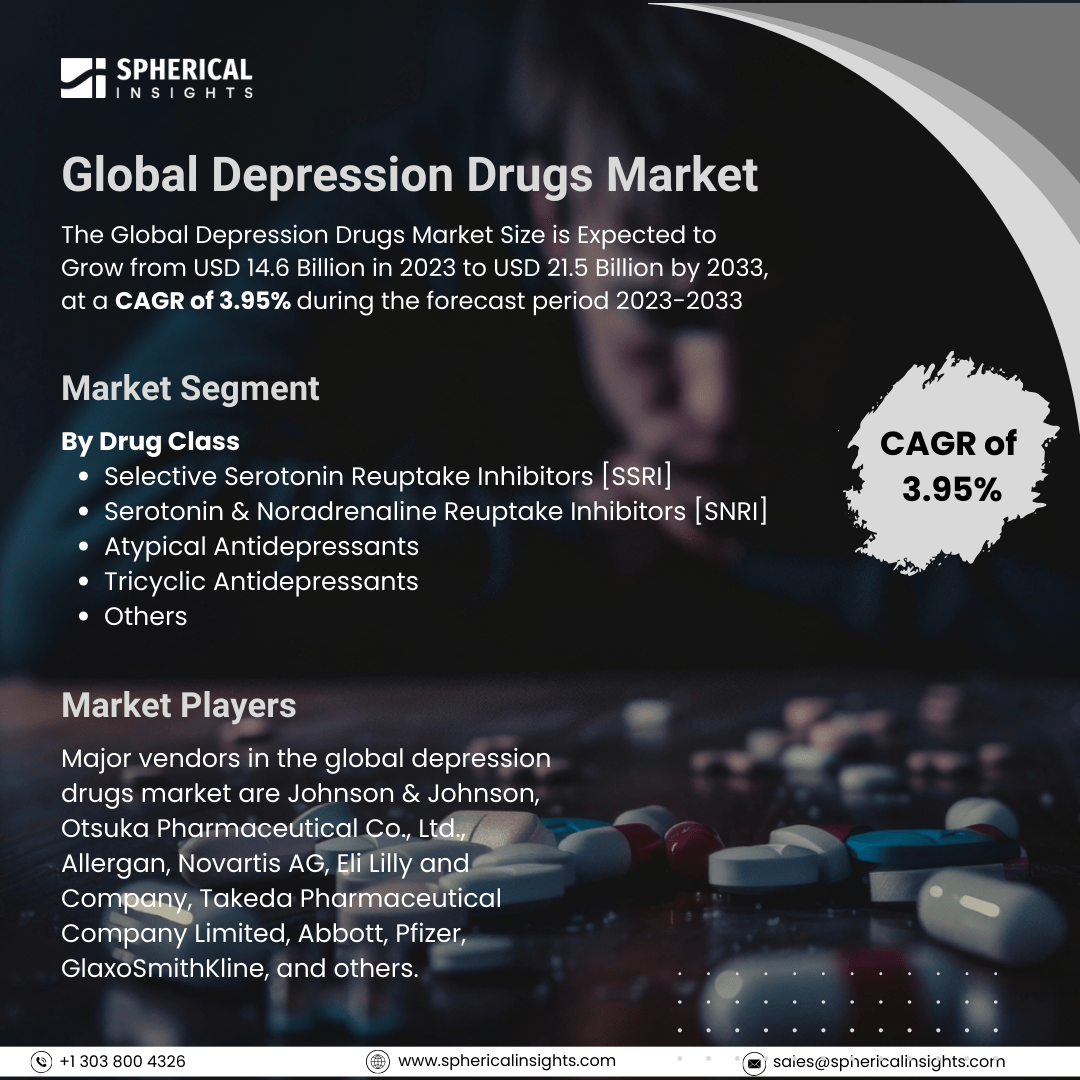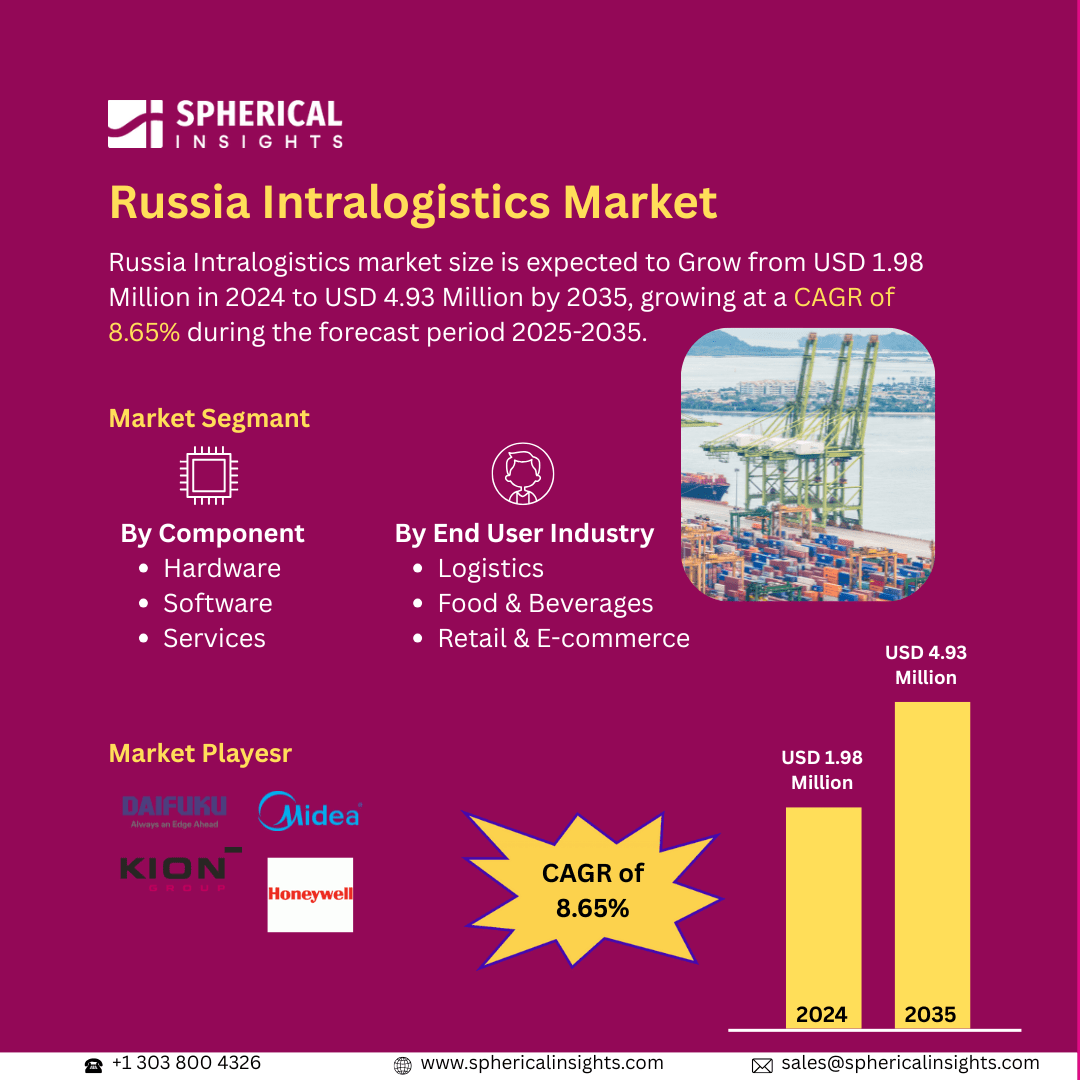Global Depression Drugs Market Size to Exceed USD 21.5 Billion by 2033
According to a research report published by Spherical Insights & Consulting, The Global Depression Drugs Market Size is Expected to Grow from USD 14.6 Billion in 2023 to USD 21.5 Billion by 2033, at a CAGR of 3.95% during the forecast period 2023-2033.
Browse 210 market data Tables and 45 Figures spread through 190 Pages and in-depth TOC on the Global Depression Drugs Market Size, Share, and COVID-19 Impact Analysis, By Drug Class (Selective Serotonin Reuptake Inhibitors [SSRI], Serotonin & Noradrenaline Reuptake Inhibitors [SNRI], Atypical Antidepressants, Tricyclic Antidepressants, and Others), By Disease Type (Major Depressive Disorder, Schizophrenia & Bipolar I Disorder, Obsessive-Compulsive Disorders [OCD], Anxiety Disorder, and Others), By Distribution Channel (Retail Pharmacies, Hospital Pharmacies, and Online Pharmacies), and By Region (North America, Europe, Asia-Pacific, Latin America, Middle East, and Africa), Analysis and Forecast 2023 – 2033.
The depression drugs market is the worldwide pharmaceutical industry sector dedicated to the creation, development, and sale of medications employed to alleviate depression. The market contains several drug classes like selective serotonin reuptake inhibitors (SSRIs), serotonin-norepinephrine reuptake inhibitors (SNRIs), tricyclic antidepressants (TCAs), monoamine oxidase inhibitors (MAOIs), and atypical antidepressants. It is propelled by drivers like the growing incidence of depression, increasing mental health awareness, drug development improvements, and the need for more effective treatment alternatives. Furthermore, the global depression drugs market is driven by rising depression prevalence, increasing mental health awareness, expanding healthcare access, and advancements in drug formulations. Growing stress levels, lifestyle changes, and the COVID-19 pandemic's impact on mental health further fuel the demand. Additionally, strong R&D investments, government initiatives, and improved reimbursement policies support market growth. However, the global depression drugs market faces restraints such as patent expirations, side effects, regulatory challenges, high R&D costs, availability of generics, social stigma, alternative therapies, slow drug approval, and market saturation.
The selective serotonin reuptake inhibitors (SSRI) segment accounted for the largest share in 2023 and is anticipated to grow at a significant CAGR during the forecast period.
On the basis of the drug class, the global depression drugs market is divided into selective serotonin reuptake inhibitors [SSRI], serotonin & noradrenaline reuptake inhibitors [SNRI], atypical antidepressants, tricyclic antidepressants, and others. Among these, the selective serotonin reuptake inhibitors [SSRI] segment accounted for the largest share in 2023 and is anticipated to grow at a significant CAGR during the forecast period. The segmental growth is attributed to its proven efficacy, favorable safety profile, and widespread prescription for major depressive disorder and anxiety. Growth is driven by increasing depression cases, rising awareness, and ongoing R&D for improved formulations with fewer side effects, making SSRIs the preferred first-line treatment globally.
The major depressive disorder segment accounted for the largest share in 2023 and is anticipated to grow at a remarkable CAGR during the forecast period.
On the basis of the disease type, the global depression drugs market is divided into major depressive disorder, schizophrenia & bipolar I disorder, obsessive-compulsive disorders [OCD], anxiety disorder, and others. Among these, the major depressive disorder segment accounted for the largest share in 2023 and is anticipated to grow at a remarkable CAGR during the forecast period. The segmental growth is attributed to its high global prevalence, increasing awareness, and rising diagnosis rates. Growth is driven by expanding mental health initiatives, improved access to treatments, and the continuous development of advanced antidepressant drugs, making MDD the primary focus in the depression drugs market.
The hospital pharmacies segment accounted for the greatest share in 2023 and is anticipated to grow at a substantial CAGR over the forecast period.
On the basis of the distribution channel, the global depression drugs market is divided into retail pharmacies, hospital pharmacies, and online pharmacies. Among these, the hospital pharmacies segment accounted for the greatest share in 2023 and is anticipated to grow at a substantial CAGR over the forecast period. The segmental growth is attributed to the high reliance on hospitals for severe depression treatments, the availability of specialized medications, and physician-supervised prescriptions. Growth is driven by increasing hospital admissions for mental health conditions, improved healthcare infrastructure, and the rising adoption of advanced antidepressant therapies in clinical settings.
North America is projected to hold the largest share of the global depression drugs market over the forecast period.
North America is projected to hold the largest share of the global depression drugs market over the forecast period. The regional growth is attributed to the high prevalence of depression and anxiety disorders, advanced healthcare infrastructure, and strong pharmaceutical R&D. Favorable reimbursement policies, widespread awareness campaigns, increasing mental health diagnoses, and the presence of key market players further drive market growth in the region.
Asia Pacific is expected to grow at the fastest CAGR growth of the global depression drugs market during the forecast period. The segmental growth is attributed to rising mental health awareness, increasing cases of depression and anxiety, expanding healthcare infrastructure, and growing government initiatives. Additionally, improving access to psychiatric care, economic growth, rising pharmaceutical investments, and the increasing acceptance of antidepressant medications contribute to the region’s rapid market expansion.
Company Profiling
Major vendors in the global depression drugs market are Johnson & Johnson, Otsuka Pharmaceutical Co., Ltd., Allergan, Novartis AG, Eli Lilly and Company, Takeda Pharmaceutical Company Limited, Abbott, Pfizer, GlaxoSmithKline, and others.
Key Target Audience
- Market Players
- Investors
- End-users
- Government Authorities
- Consulting and Research Firm
- Venture capitalists
- Value-Added Resellers (VARs)
Recent Development
- In July 2023, the KOASTAL Program, a Phase 3 pivotal clinical program intended to assess the safety and effectiveness of navacaprant (NMRA-140) monotherapy for the treatment of major depressive disorder (MDD), is set to begin soon, according to Neumora Therapeutics, Inc.. This clinical-stage biopharmaceutical company is revolutionizing the development of neuroscience drugs. A novel and highly selective kappa opioid receptor (KOR) antagonist called navacaprant (NMRA-140) is being developed as a possible monotherapy treatment for major depressive disorder.
Market Segment
This study forecasts revenue at global, regional, and country levels from 2023 to 2033. Spherical Insights has segmented the global depression drugs market based on the below-mentioned segments:
Global Depression Drugs Market, By Drug Class
- Selective Serotonin Reuptake Inhibitors [SSRI]
- Serotonin & Noradrenaline Reuptake Inhibitors [SNRI]
- Atypical Antidepressants
- Tricyclic Antidepressants
- Others
Global Depression Drugs Market, By Disease Type
- Major Depressive Disorder
- Schizophrenia & Bipolar I Disorder
- Obsessive-Compulsive Disorders [OCD]
- Anxiety Disorder
- Others
Global Depression Drugs Market, By Distribution Channel
- Retail Pharmacies
- Hospital Pharmacies
- Online Pharmacies
Global Depression Drugs Market, By Regional
- North America
- Europe
- Germany
- UK
- France
- Italy
- Spain
- Russia
- Rest of Europe
- Asia Pacific
- China
- Japan
- India
- South Korea
- Australia
- Rest of Asia Pacific
- South America
- Brazil
- Argentina
- Rest of South America
- Middle East & Africa
- UAE
- Saudi Arabia
- Qatar
- South Africa
- Rest of the Middle East & Africa



